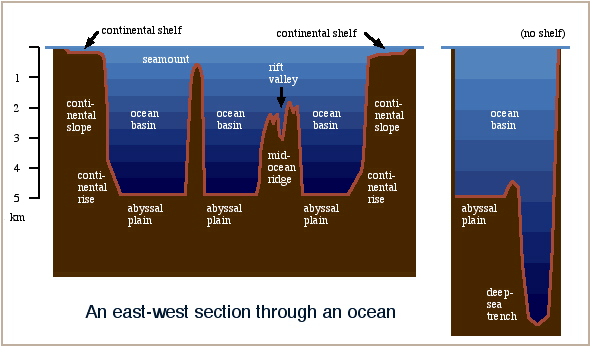
This sketch shows some major topographic features of a "typical" ocean. The section runs in a zonal direction.
The coast is the visible boundary between ocean and land, but it does not necessarily coincide with the geological boundary between the ocean basins and the continents. In most situations the continens have a submerged base, consisting of the shelf, slope and rise and known as the continental margin. The transition between continents and ocean occurs between the continental rise and the abyssal plain.

The ocean floor is structured into mid-ocean ridges and abyssal plains. The system of ridges divides the ocean into a series of distinct deep regions known as basins. The central parts of the basins have been filled by sediment for many millions of years, and the accumulated sediment layer covers all topographic relief, making the interior of the basins the flattest parts of the earth's surface. These regions are called the abyssal plain.
Seamounts or abyssal hills are isolated features on the abyssal plain that rise above 1000 m below the sea surface. They are mostly of volcanic origin and rose above sea level at some time in their history but have sunken below it. Erosion from the period when the waves could lap over their surface gave them a flat top.
Where oceanic crust activity subducts below the continent, the ocean floor is pushed downward near the coast. There is then no continental margin; a deep-sea trench is formed instead (as sketched in the right part of the diagram).
The next pages show the distribution of the various features sketched in the diagram and discussed above, as they occur in the world ocean.